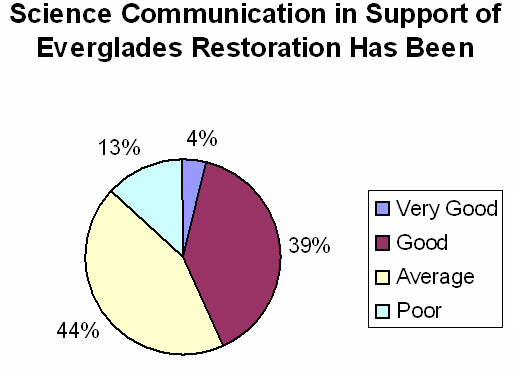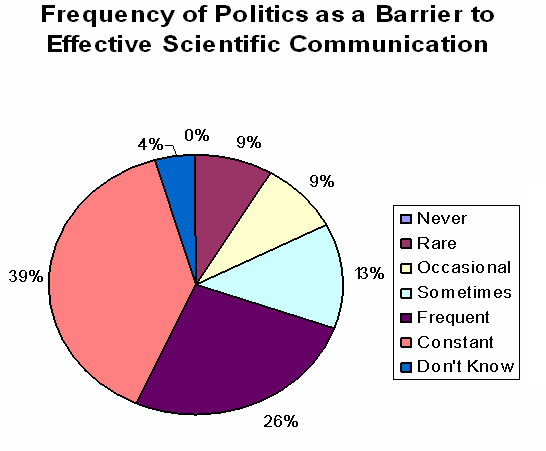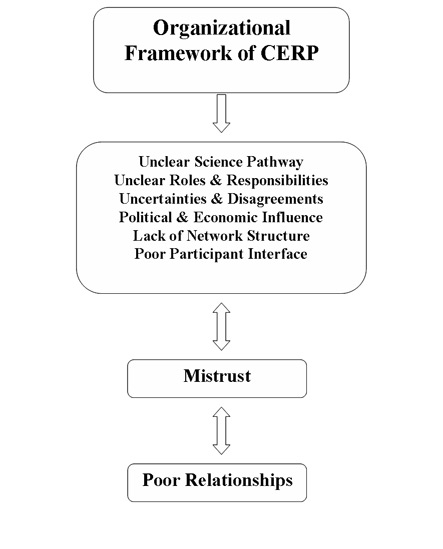Science in the Everglades: The Interface between Scientists and Managers
Authors
Holly E. Fling
Introduction
Environmental problems involve natural and social systems that cross jurisdictional boundaries, bring into contention widely differing stakeholder values, and are managed by a highly fragmented regulatory patchwork. Large-scale ecosystem restoration is one of the most important challenges we face. The water flow pattern of the Greater Everglades system was drastically altered from 1850-1950 to provide for development, flood protection, water supply, and agriculture. The Comprehensive Everglades Restoration Plan (CERP) is the largest ecological restoration ever undertaken in the United States. Currently a variety of barriers are preventing efficient and effective restoration. I used personal confidential interviews and a web survey with upper-level scientists and decision makers in CERP to identify barriers to restoration progress.
Predicted Pre-Drainage System

Figure 1: Ridge and slough landscape within the predicted pre-drainage system, circa 1850. Source.
Motivation
Is Everglades science impacting the decision making for the restoration?
If not, why not?
Research Questions
- How is restoration-related scientific information communicated in CERP?
- What are the major barriers to collaboration among restoration practitioners involved with Greater Everglades restoration?
- Has the interface between scientists and managers contributed to the lack of progress in the Everglades restoration?
Methods
29 Personal confidential interviews and a web survey (n=23) were conducted in 2005 with restoration practitioners from the following agencies USACE, SFWMD, FFWC, USFWS, USDA, NPS, EPA, Tribes, and NGOs.
Results
Communication in large-scale ecosystem restorations is extremely difficult due to number of stakeholders and differing motivations, incentives, and responsibilities. Most scientists believed communication in CERP to be poor; managers believed the communication to be adequate or good.
A Major Barrier to Communication is Collaboration

4 Major Barriers to Collaboration of CERP participants:
- Organizational Framework
- Uncertainties & complexity of the biophysical ecosystem
- Political & Economic pressures
- Interpersonal relationships
Organizational Framework Limitations
- Logistical constraints
- Poor leadership
- Agency affiliation
- Political influence
Uncertainties & Complexities of Biophysical Ecosystem
- Baseline data
- Effects of management decisions
- What is restoration?
Political & Economic Pressures
Main political and economic pressures are a result of land development and real estate pressures.
37% of Interviewees believe that real estate development is drowning the restoration

Scientist quoted:
"A policy of pretty much unregulated, unplanned development at the state level and the county level is just not in synch with restoration, or even stopping the damage that is currently ongoing, the current degradation. Every day, every new house that goes up is another bite- another water user, another waste load and it probably would be adequate if there was some sort of a plan that said there is a limit."
Lack of restoration transparency has resulted in questioning restoration goals and participant motivation.
Scientist quoted:
"CERP is sold as a science driven process, which would tend to mean that science has a higher standing than some political aspects. I don't see CERP and restoration initiatives being a whole lot different than other processes that have science as one part of the information".
Manager quoted:
"Do you truly want to restore the Everglades America? Is this truly a national treasure? Are you serious about this? And if you are, please explain to me how you plan to keep 6 million people down there in a sustainable environment and how you even forecast that to grow to 10 or 15 million people by the year 2025 and you're still going to maintain the Everglades? Tell me that please, because I don't think we can".
Interpersonal Relationships
50% Interviewees reported cultural differences between scientists and managers
20% Interviewees reported the "editing" of reports to display positive results
Scientist quoted:
"There have been a number of examples in Florida, where people have lost their jobs because of conflict between what they said and what the Federal government or state wanted them to say...These folks, both at the state level and Federal level have been asked to leave their position because as senior scientists they had a conflict of opinion with management and those are the people who implement policy so it is pretty clear that in Florida there is a bias towards implementing policy whether or not science supports it."

Recommendations for Future Large-Scale Ecosystem Restorations
- Collaboratively and transparently identify restoration goals
- Identify responsibilities and communication channels in organizational framework
- Create restoration task force without other agendas
- Establish participant network structure
- Reduce cultural barriers
Citation
Fling, Holly. (2006, June). Science in the Everglades: The Interface between Scientists and Managers. Poster presented at the Greater Everglades Ecosystem Restoration Conference, Orlando, Florida.




